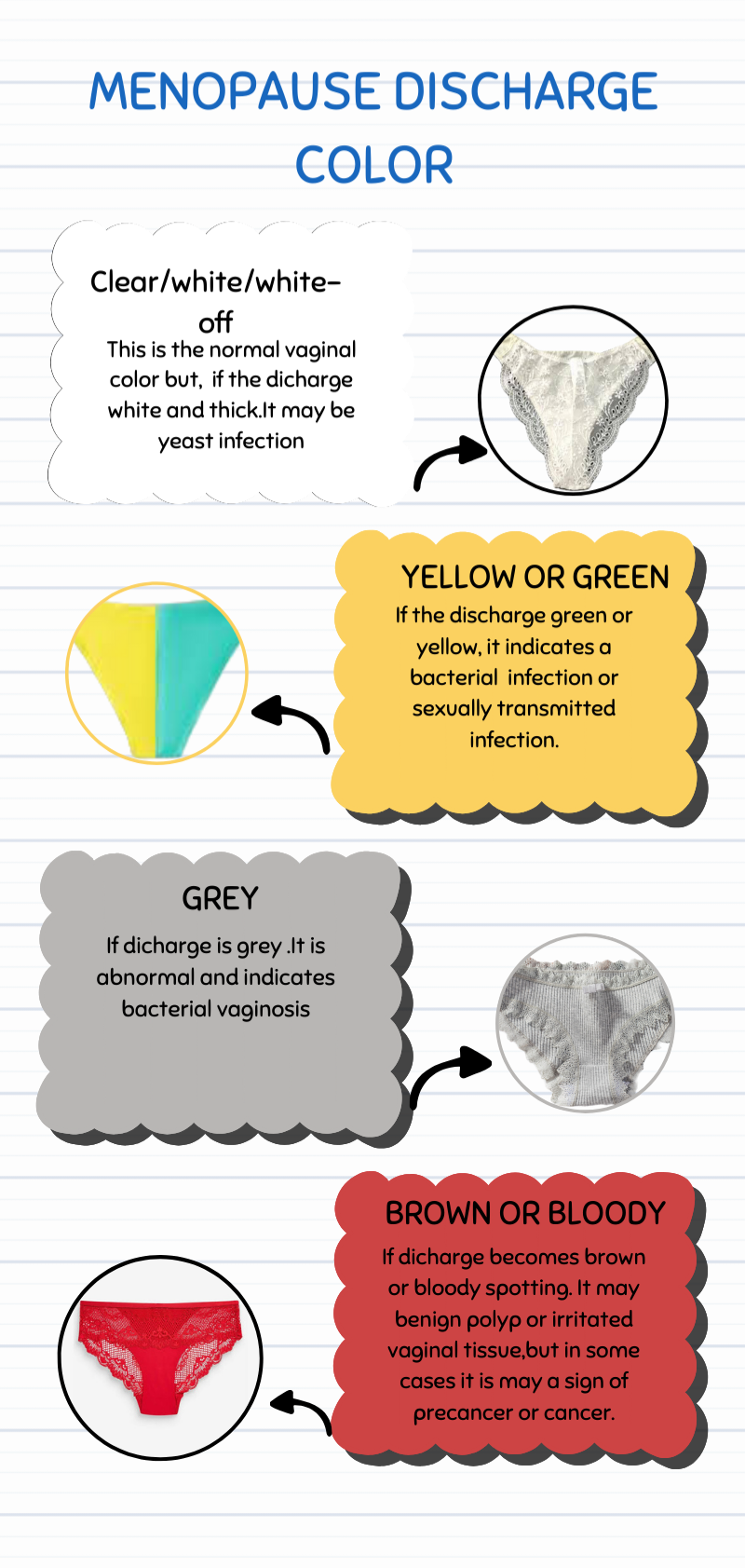Menopause discharge color varies from one woman to another due to the level of estrogen and progesterone hormones decreasing after experiencing menopause.
As we know menopause happens when a woman’s menstruation stops for 12 months in a row, but some women may notice that bodily changes years before this as perimenopause.
These changes happened leading us to ask if these changes are considered normal or abnormal. So, let's know how they could be when you should visit a doctor and what tips you can follow to keep a healthy vaginal discharge after menopause.

What are the vaginal discharge changes can women expect after menopause?
After menopause don't worry if you do still produce some liquid, which is clear, it is normal discharge, but you may experience some symptoms such as vaginal dryness as the vagina will be less elastic and have a thinner wall after menopause.
This can be uncomfortable and irritating due to a decrease in estrogen, resulting in discharge production reduction, but using a vaginal lubricant can help in this situation, but how could you distinguish between normal and abnormal discharge? Read the information below
Normal menopause discharge color
The healthy vaginal discharge is typically white or clear. However, the quantity, color, and consistency of vaginal discharge can be different from one woman to another.
Normal menopause discharge color has the following characteristics:
- Clear or white
- Does be sticky to the vagina’s walls
- Does not have an offensive smell or cause any irritation

Abnormal menopause discharge color
Due to lack of vaginal lubrication and pH level disruption, vaginal discharge after menopause can be abnormal, and discharge color will be differently related to a specific disease as the following signs:
Yellow or green vaginal discharge
If vaginal menopause discharge color becomes yellow or green, it may be a sign of a sexually transmitted infection like gonorrhea or trichomoniasis especially If it has a foul odor and you have pain or bleeding.
If you have these signs, seek medical health advice to be diagnosed and take antibiotics.
White, thick vaginal discharge
If the vaginal menopause discharge color is white and thick like cottage cheese, it could be indicative of a yeast infection, especially if it’s accompanied by itching, burning, or pain. You can visit a doctor to have an antifungal treatment.
Gray vaginal discharge
The most common cause of gray vaginal discharge is bacterial vaginosis due to an imbalance between good and bad bacteria in the vagina, which can become more common after menopause.
This condition can cause a foul-smelling odor, itching, and burning during urination. If you have these symptoms, visit a doctor to take antibiotics.
Brown or bloody vaginal discharge
If your menopause discharge color becomes brown or bloody spotting, it could be caused by a benign polyp or even irritated vaginal tissue, but in some cases, it may be a sign of uterine precancer or cancer. So, if you have this you should visit a doctor and be examined.
Now let's talk about the causes that can lead to a change in normal menopause discharge color.
Abnormal menopause discharge color causes
Vaginal atrophy
People who have menopause can develop vaginal atrophy due to low estrogen levels leading to thinning of the vagina wall and change in vaginal discharge, especially after sexual contact.
If discharge appears thin, watery, and yellow or gray, it might indicate an acidity imbalance of the vagina and bacterial overgrowth. These bacteria can cause vaginal inflammation and infections.
Endometrial hyperplasia
Endometrial hyperplasia is most common among women after menopause, especially in their 50s and 60s.
It caused due to imbalance levels of estrogen and progesterone resulting in increased thickness of the uterine and making brown vaginal discharge, and if untreated, it may develop into endometrial cancer.
Vaginal thrush
It is caused by a yeast infection called candida albicans overgrowth due to imbalanced hormones in the vagina after menopause making the vagina itchy, burning, and painful, and the vaginal discharge has whitish-yellowish color.
Desquamative inflammatory vaginitis
It most commonly occurs after menopause, which is a type of vaginal inflammation that is not related to bacterial or fungal infection. The vagina becomes irritated, inflamed, itchy, and vaginal discharge increases and becomes yellowish green.

What can you do if you have abnormal menopause discharge color?
If you notice abnormal menopause discharge color accompanied by itching and pain, firstly make an appointment with a medical health provider to be diagnosed and take the appropriate treatment, there are some healthy tips to help you to decrease symptoms or prevent their occurrence as
Wear comfortable cotton underwear and usually change them, especially when they get wet
Underwear of synthetic material or is tight will irritate the vagina.
Use an unscented panty liner
Use unscented panty liner to keep the area always dry, and change it often.
Wash your genital area gently with water and avoid using soap
If you have sensitivity to soap, wash with your hands, don't use a washcloth or loofah, which may cause irritation, and avoid hot tubs.
Be always sure that the area is always dry
Make sure you wipe the area after bathing or showering with a soft towel don't use fabric softeners or dryer sheets and rinse thoroughly.
Avoid douching
Douching can disrupt the balance of healthy bacteria in the vagina specially douching with feminine hygiene products and can lead to infections.
Avoid bathing with products containing fragrances
Avoid using these products or any other harsh ingredients that may cause the vagina to be irritated.
Wash your underwear in gentle detergent
Wash with a gentle detergent to avoid irritation.
Consider a probiotic for vaginal health
Taking a vaginal probiotic which contains live, active lactobacillus strains can help to balance and maintain a healthy vaginal microbiome.
Clean the area gently after using the toilet
After using the toilet, always wipe from front to back to prevent getting bacteria from your rectal area into your vagina.
Summary
Finally, we can summarize that every woman can have variation in menopause discharge color, and every color can indicate if vaginal discharge is normal or abnormal, and how to deal with these changes by taking suitable medication and following healthy habits.


You must be logged in to post a comment.